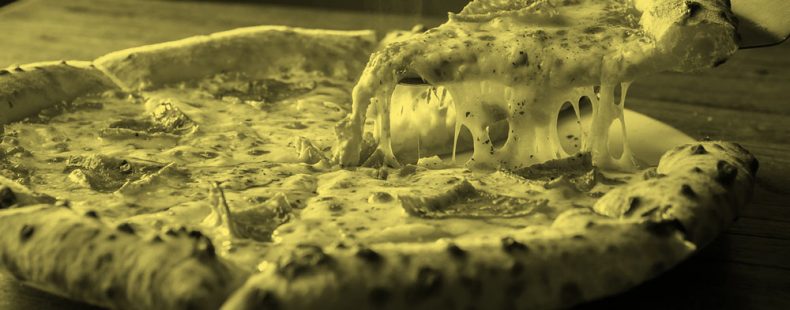The origin of the word pizza
The word pizza as we now know it is recorded in English in the early 1800s, though early English lexicographer John Florio enters pizza for “a small cake or wafer” in his historically important 1598 Italian-English dictionary. Pizza, of course, is borrowed from Italian, but the deeper ingredients of the word, if you will, are unclear. Some think the Greek pitta (pita, with a root sense of “bran bread”) is the source. Others look to the Langobardic (an ancient German language in northern Italy) bizzo, meaning “bite.”
Whatever the origin, we say, “delicious.”
Who invented pizza?
When it comes to the history of pizza, Italians are credited with inventing modern pizza, but a baked bread with toppings has many other ancestors in other cuisines.
Italy’s version of the dish, especially from Naples, is the one we are most familiar with, though pissaladière from Provence, coca from Catalonia, and lahmacun (among other forms) from the Middle East all bear a remarkable resemblance to pizza.
As the legend goes, modern pizza—an open-faced pie slathered in tomato sauce and mozzarella—was given to us in the 18th century by the baker Raffaele Esposito in Naples, Italy. In 1889, he made a patriotic pie topped with mozzarella, basil, and tomatoes, ingredients in the colors of the Italian flag, in honor of King Umberto and Queen Margherita’s visit. It is rumored the Queen enjoyed the pie, and thus, it became known as a Margherita.
In the US, Italian immigrants sold pizza in their stores, and the first pizzeria (Lombardi’s) was opened in 1905 by Gennaro Lombardi on Spring Street in New York City, but pizza did not truly not catch on stateside until World War II. Stationed in Italy, many American and European soldiers tasted pizza and brought an appetite for this now-ubiquitous dish home with them. Today, you’ll find pizza sold in Italian food restaurants and by street vendors around the world, which means you’ll never need to look far if you’re craving a flatbread pizza with crunchy crust baked with olive oil. Tasty!
Is it a pie, a pizza, or a pizza pie?
What do you call your pizza? On the East Coast of the US, pie or pizza pie are popular terms for an entire pizza. In other regions (and outside the US), these terms would never be used. However, the use of pie for pizza dates back to the 1800s. In 1903, a New-York Tribune article noted “Pie has traditionally been considered a Yankee dish exclusively” and goes on to describe a “pomidore pizza,” a dish made of dough and tomatoes. Za is another version of pizza. This is known as a clipping: a whole word shortened while retaining its original meaning.
As there are many names for pizza, so too are there lots of different styles of pizza. Some of the more popular (and delicious) styles of pizza include:
- New York
- Neapolitan
- Chicago deep dish
- Sicilian
- Californian
- Detroit
- St. Louis
- Hawaiian
- Greek
- Roman
If you want to sound like a true pizzaiolo (a pizza maker), you’ll call your discarded crust bones and judge a pizza by its leopard spots (the black spots on the crust) or its hole structure (the holes in the bread’s interior).














